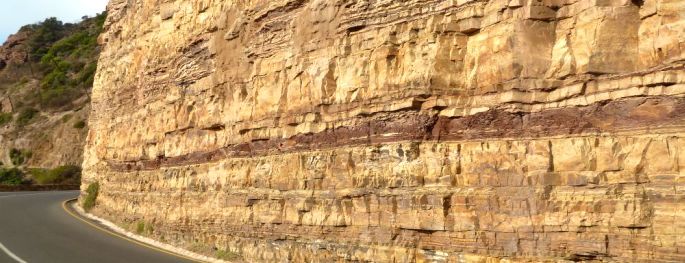Cape Peninsula sandstones, South Africa, deposited during Noah’s Flood
Published: 26 July 2012 (GMT+10)
georneys.blogspot9

Maroon mudstone beds and buff sandstone beds alongside Chapman’s Peak Drive south of Cape Town.
Geologists have called these sediments the Graafwater Formation, which is around 70 metres (200 ft) thick along Chapman’s Drive.1 Above it sits another 550 metres (1800 feet) of sedimentary strata, the Peninsula Formation, which lacks the distinctive maroon mudstone layers.2 The Peninsula Formation forms the impressive cliff faces prominent in Table Mountain and the escarpments above Chapman’s Peak Road.2
There are many features of these sandstone deposits on the peninsula that point to large-scale, rapid deposition
- The sediments cover a large geographical area. McCarthy and Rubidge have a geologic map that shows the Table Mountain Group extending beyond Port Elizabeth, 700 km (400 miles) to the east, and almost as far as Vanrhynsdorp, 300 km (200 miles) to the north.3 This points to a geologic process that covered a very large area, as would be expected from Noah’s Flood.
- The sandstone beds are “amazingly uniform”.2 This feature can be seen in the above image of the road cut, but also from a distance when you look at the escarpments in the area, such as the escarpment of Table Mountain or of the Twelve Apostles. Once again, this points to an energetic geologic process that covered a large area.
- The sandstone beds are frequently quite thick, some as thick as 6 metres (20 feet).4 This points to a large water flow with abundant sediment, again as would be expected from the Flood catastrophe.
- The continuous nature of the sedimentation indicates continually rising sea level. There is no evidence of erosion or a break in deposition at the contact between the two formations, so geologists believe that the sediments represent a process of continuous deposition.5
- Sedimentary structures indicating flowing water are common, including large trough and tabular cross bedding.6
- Abundant wave and ripple marks, again indicating flowing water.6
- The sedimentary beds show evidence of slumping, including load casts.6 Imagine how a billiard ball placed on a layer of soft mud would sink into the mud. When sand is deposited onto soft sediment, blobs of sand will sink into the underling mud forming ‘load casts’. These features indicate deposition so rapid that the sediments are still uncompacted and loose.
- Well rounded quartz pebbles up to 70 mm (3 inches) in diameter are distributed through the sandstone, sometimes forming thin lenses of pebble conglomerate.6 These stones give an idea of the water flow needed to carry them along.









